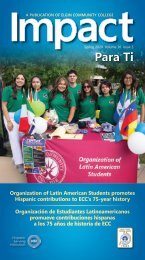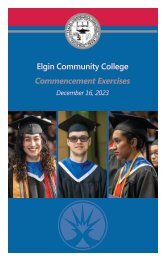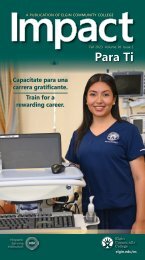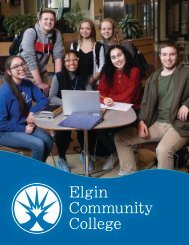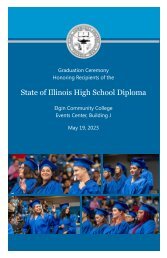ILEA Equity Plan | Elgin Community College (ECC)
There are wide and persistent gaps in college completion rates in Illinois, especially among students of color and low-income students. After an in-depth analysis of our institutional data, Elgin Community College (“ECC” or “the College” or “we” or “our”) has developed an Equity Plan containing annual growth targets for which progress updates will be shared publicly over the next five years. Our Equity Plan reflects the unique characteristics of our institution. For example, ECC is designated as a Hispanic Serving Institution by the US Department of Education, with just over 42% of the students identifying as Latinx or Hispanic. Also, the district served by ECC is widely diverse in terms of income and educational attainment. We will identify the obstacles students face and develop programs and policies that break down unnecessary college graduation barriers. Along with our fellow colleges, in the Partnership for College Completion organization, with this Illinois Equity in Attainment (“ILEA”) plan, we pledge to close the completion gaps by 2025.
There are wide and persistent gaps in college completion rates in Illinois, especially among students of color and low-income students. After an in-depth analysis of our institutional data, Elgin Community College (“ECC” or “the College” or “we” or “our”) has developed an Equity Plan containing annual growth targets for which progress updates will be shared publicly over the next five years. Our Equity Plan reflects the unique characteristics of our institution. For example, ECC is designated as a Hispanic Serving Institution by the US Department of Education, with just over 42% of the students identifying as Latinx or Hispanic. Also, the district served by ECC is widely diverse in terms of income and educational attainment. We will identify the obstacles students face and develop programs and policies that break down unnecessary college graduation barriers. Along with our fellow colleges, in the Partnership for College Completion organization, with this Illinois Equity in Attainment (“ILEA”) plan, we pledge to close the completion gaps by 2025.
Create successful ePaper yourself
Turn your PDF publications into a flip-book with our unique Google optimized e-Paper software.
3A. Goal<br />
Table 7. 2018-2022 Strategic <strong>Plan</strong><br />
Theme: EQUITY AND<br />
LEARNING<br />
Goal: Identify an expand<br />
practices to raise academic<br />
achievement and completion<br />
Strategy 1: Create equitable<br />
learning environments to<br />
ensure students acquire the<br />
knowledge and skills needed<br />
for academic and career<br />
success<br />
Strategy 2: Develop students'<br />
self-advocacy skills and<br />
professional behaviors<br />
Strategy 3: Study and model<br />
research-based teaching<br />
practices that elevate student<br />
learning<br />
3. Future Vision<br />
The goal of <strong>ILEA</strong> <strong>Equity</strong> <strong>Plan</strong> is, over the course of five years, to incrementally close the<br />
completion gap among African American, Latinx, and Pell Grant recipients so that there is no<br />
difference from the other students. The targets are further defined in Section 3C. Interim<br />
Benchmark Goals. We are committed to reaching these targets by implementing the strategies<br />
presented in Section 4. Institutional Strategies.<br />
3B. Vision<br />
Our <strong>Equity</strong> <strong>Plan</strong> is integrated into <strong>ECC</strong>’s overarching five year Strategic <strong>Plan</strong> for 2018 to 2022<br />
(Table 7). The four main themes of our Strategic <strong>Plan</strong> are: <strong>Equity</strong> and Learning; Holistic<br />
Programming; <strong>Community</strong> Partnerships; and Service Excellence and Collaboration. The themes<br />
have a total of 14 strategies. A more detailed annual Operating <strong>Plan</strong> further drills down these<br />
strategies into 21 specific actions to be completed every year over the five year cycle. For<br />
example, completing the <strong>ILEA</strong> <strong>Plan</strong> was action item in service of Strategy 1: Create equitable<br />
learning environments to ensure students acquire the knowledge and skills needed for academic<br />
and career success. The Operating <strong>Plan</strong> is developed by the Cabinet with the input from<br />
students, employees, and external partners. It is intended to guide operations and budgets of<br />
<strong>ECC</strong> departments, offices, and committees. It is also used as a framework for tracking progress<br />
and reporting. The plan is a work in progress and reexamined periodically as the college<br />
deploys the <strong>ECC</strong> Strategic <strong>Plan</strong>. The Strategic <strong>Plan</strong> is posted on our website and is displayed on<br />
posters throughout campus and invites comments to be sent to an email box for consideration.<br />
Theme: HOLISTIC<br />
PROGRAMMING<br />
Goal: Strategically build and<br />
maintain enrollment and<br />
purposeful pathways<br />
Strategy 4: Strengthen<br />
outreach, recruitment,<br />
retention, and completion of<br />
key target populations<br />
Strategy 5: Routinely assess<br />
and adjust college practices to<br />
ensure students make informed<br />
decisions<br />
Strategy 6: Develop an<br />
institution-wide approach to<br />
class scheduling and the<br />
efficient delivery of services<br />
Theme: COMMUNITY<br />
PARTNERSHIPS<br />
Goal: Advance relationships<br />
that benefit the college,<br />
students, and partnering<br />
organizations<br />
Strategy 7: Prepare students<br />
and ensure successful<br />
transitions through the<br />
educational pipeline (preschool<br />
through bachelor’s degree)<br />
Strategy 8: Strengthen student<br />
learning connections outside<br />
the classroom<br />
Strategy 9: Leverage<br />
community and workforce<br />
partnerships to develop<br />
resources and secure funding<br />
that supports program and<br />
student needs<br />
Strategy 10: Design and<br />
structure programs in ways that<br />
respond to community and<br />
workforce needs<br />
Theme: SERVICE EXCELLENCE<br />
Goal: Instill a culture of<br />
service excellence and<br />
collaboration<br />
Strategy 11: Provide relevant<br />
continuing education<br />
opportunities for employees<br />
Strategy 12: Improve<br />
recruitment, hiring, and<br />
onboarding of new employees<br />
Strategy 13: Strengthen crossdepartmental<br />
communication<br />
and opportunities for dialog<br />
and reflection<br />
Strategy 14: Systematically use<br />
evidence to guide academic<br />
and operational Improvements<br />
and redirect resources for<br />
maximum impact









